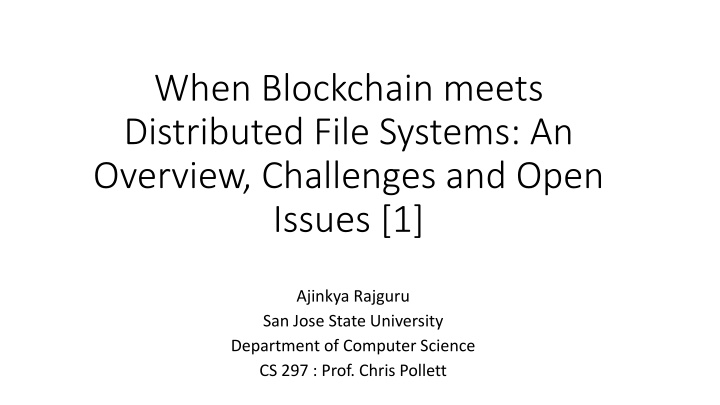
Decentralized File Systems: IPFS, SWARM, and Blockchain Integration
Explore the layered architecture, advantages, challenges, and current studies of integrating IPFS and SWARM with blockchain for distributed file systems. Learn about IPFS as a peer-to-peer file system and SWARM as a decentralized data storage technology that works with blockchain, including components of the layered architecture and associated challenges like scalability.
Download Presentation

Please find below an Image/Link to download the presentation.
The content on the website is provided AS IS for your information and personal use only. It may not be sold, licensed, or shared on other websites without obtaining consent from the author. If you encounter any issues during the download, it is possible that the publisher has removed the file from their server.
You are allowed to download the files provided on this website for personal or commercial use, subject to the condition that they are used lawfully. All files are the property of their respective owners.
The content on the website is provided AS IS for your information and personal use only. It may not be sold, licensed, or shared on other websites without obtaining consent from the author.
E N D
Presentation Transcript
When Blockchain meets Distributed File Systems: An Overview, Challenges and Open Issues [1] Ajinkya Rajguru San Jose State University Department of Computer Science CS 297 : Prof. Chris Pollett
Agenda Introduction Introduction to IPFS Introduction to SWARM Layered Architecture Advantages and Disadvantages Cutting edge studies Conclusion
Introduction This paper gives an overview of the layered structure, cutting-edge studies and challenges of IPFS and SWARM blockchain based distributed filesystems.
IPFS Interplanetary File System is a peer-to-peer file system for storing and accessing files, websites, applications and data [3].
SWARM SWARM is a decentralized data storage and distribution technology [2]. It has storage capability that work with blockchain enabling Ethereum based smart contracts [2].
Components of the Layered Architecture Layers IPFS SWARM Identity Layer Encrypted hash of Node ID Keccak hash of public key of Ethereum account Routing Layer DSHT ( Distributed sloppy Hash table) Distributed Preimage Archive (DPA) Network Layer libP2P DevP2P Data Layer Block Arbitrary sized data List collection of blocks Tree collection of blocks, lists, trees Commit -Snapshot Chunk fixed-size piece of data (4 KB max) File complete set of chunks Manifest mapping between paths and files
Components of the Layered Architecture Layers IPFS SWARM Incentive Layer Filecoin blockchain based digital payment system Ethereum token Makes use of SWARM Account Protocol (SWAP) Consensus Layer Expected consensus Transaction Proof, Proof of Replication, Proof of Spacetime Proof of work and Proof of stages Data-swap Layer BitSwap based on bitTorrent protocol Nodes store chunks for selling to get profits on data retrieve request
Issues and Challenges Scalability performance Limited bandwidth of each instance of IPFS could cause low scalability. Bottlenecks of resolving and downloading while accessing remote nodes. Efficient updating technique ( change in hash address as the file changes) Need better performance measurement methodologies and system measurement standards.
Issues and Challenges Privacy and Security Issues Some current versions of DFS like IPFS do not tolerate Byzantine attacks. Every peer can access every file in IPFS.
Applications IPFS provides business solutions to enterprise Storing data Opus, a music sharing platform makes uses of both IPFS and Ethereum. IPSE proposed a new search engine built on top of IPFS and blockchain. IPFS and SWARM can be combined with big data applications Can be used for secure storage in IoT Uses in Data Analytics
Cutting edge studies of blockchain For IPFS average download time increases with increase in cluster size and growth in replication. Storage optimization Can explore Erasure codes and storing data off-chain Transparent transactions call for improved privacy Access control and Peer Anonymity.
Conclusion The new generation of blockchain based distributed filesystems have great potentials with key characteristics Novel solution of incentive Low-latency data retrieval Automated auditing Censorship-resistant
References [1] [2020] When Blockchain Meets Distributed File Systems: An Overview, Challenges, and Open Issues. H. Huang, J. Lin, B. Zheng, Z. Zheng and J. Bian. IEEE Access, vol. 8, pp. 50574-50586, 2020, doi: 10.1109/ACCESS.2020.2979881 [2] https://www.ethswarm.org [3] https://en.wikipedia.org/wiki/InterPlanetary_File_System
